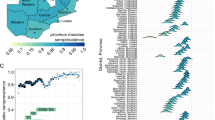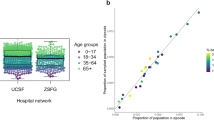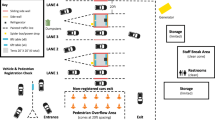Abstract
Seroepidemiologic studies, which measure serum antibody levels produced in response to infection and/or vaccination, can be valuable tools for gaining insight into population level dynamics of infectious diseases. However, because seroepidemiologic studies are expensive and logistically challenging, they are not routinely conducted for surveillance purposes. We have identified a novel venue, state fairgrounds, in which annual sera samples from a population may be rapidly collected with minimal recruitment expenses. We conducted a pilot pertussis seroepidemiologic study over the course of 3 days at the 2016 Minnesota State Fair to determine if this setting, which hosts nearly 2 million visitors over 12 days each year, is viable for facilitating larger seroepidemiologic studies. A total of 104 adults and children were enrolled to provide a finger stick blood sample for serologic testing and to take a written survey regarding recent cough illness and pertussis vaccination. The survey was used to distinguish between antibodies induced by vaccination and pertussis infection. Elevated antibodies suggestive of recent infection were found among two adults. The prevalence of undetectable antibodies, suggestive of susceptibility, was 72.3% (95% CI 59.6, 85.1%) among 7–17 year olds, 53.8% (95% CI 26.7, 80.9%) among 1–6 year olds, and 23.3% (95% CI 8.2, 38.5%) among adults. Our ability to rapidly enroll participants and collect satisfactory specimens suggests that seroepidemiologic studies with 1000–2000 participants could efficiently be completed over the 12-day course of the Minnesota State Fair. This setting raises the possibility of efficiently conducting annual population-based seroepidemiologic studies to supplement traditional public health surveillance in estimating disease prevalence, monitoring vaccine impact, and identifying at-risk groups.

Similar content being viewed by others
References
Metcalf, J. E., Farrar, J., Cutts, F. T., et al. (2016). Use of serological surveys to generate key insights into the changing global landscape of infectious disease. The Lancet, 388(10045), 728–730. https://doi.org/10.1016/S0140-6736(16)30164-7.
Cagney, M., McIntyre, P. B., Heron, L., Giammanco, A., & MacIntyre, C. R. (2008). The relationship between pertussis symptomatology, incidence and serology in adolescents. Vaccine, 26(44), 5547–5553. https://doi.org/10.1016/j.vaccine.2008.08.009.
McNamara, L. A., Skoff, T., Faulkner, A., et al. (2017). Reduced severity of pertussis in persons with age-appropriate pertussis vaccination-United States, 2010-2012milder pertussis in vaccinated people. Clinical Infectious Diseases, 65(5), 811–818. https://doi.org/10.1093/cid/cix421.
Althouse, B. M., & Scarpino, S. V. (2015). Asymptomatic transmission and the resurgence of Bordetella pertussis. BMC Medicine, 13(1), 146. https://doi.org/10.1186/s12916-015-0382-8.
CDC. (2016). Pertussis: Surveillance and reporting. Washington, DC: Centers for Disease Control and Prevention. Retrieved June 6, 2016, from http://www.cdc.gov/pertussis/surv-reporting.html.
Baptista, P. N., Magalhaes, V. S., & Rodrigues, L. C. (2010). The role of adults in household outbreaks of pertussis. International Journal of Infectious Diseases, 14(2), 0–3. https://doi.org/10.1016/j.ijid.2009.03.026.
Deville, J. G., Cherry, J. D., Christenson, P. D., et al. (1995). Frequency of unrecognized Bordetella pertussis infections in adults. Clinical Infectious Diseases, 21(3), 639–642.
Koh, M. T., Liu, C. -S., Chiu, C. -H., et al. (2016). Under-recognized pertussis in adults from Asian countries: A cross-sectional seroprevalence study in Malaysia, Taiwan and Thailand. Epidemiology and Infection, 144(6), 1192–1200. https://doi.org/10.1017/S0950268815002393.
Jõgi, P., Oona, M., Toompere, K., Leedo, S., Epstein, J., & Lutsar, I. (2014). Seroprevalence of IgG antibodies to pertussis toxin in children and adolescents in Estonia. Vaccine, 32(41), 5311–5315. https://doi.org/10.1016/j.vaccine.2014.07.066.
Lavine, J. S., King, A. A., & Bjørnstad, O. N. (2011). Natural immune boosting in pertussis dynamics and the potential for long-term vaccine failure. Proceedings of the National Academy of Sciences USA, 108(17), 7259–7264. https://doi.org/10.1073/pnas.1014394108.
Tartof, S. Y., Lewis, M., Kenyon, C., et al. (2013). Waning immunity to pertussis following 5 doses of DTaP. Pediatrics, 131(4), e1047–e1052. https://doi.org/10.1542/peds.2012-1928.
Wang, C. -Q., & Zhu, Q. -R. (2011). Seroprevalence of Bordetella pertussis antibody in children and adolescents in China. The Pediatric Infectious Disease Journal, 30(7), 593–596. https://doi.org/10.1097/INF.0b013e31820eaf88.
Campbell, P., McIntyre, P., Quinn, H., Hueston, L., Gilbert, G. L., & McVernon, J. (2012). Increased population prevalence of low pertussis toxin antibody levels in young children preceding a record pertussis epidemic in Australia. PLoS ONE. https://doi.org/10.1371/journal.pone.0035874.
Cutts, F. T., & Hanson, M. (2016). Seroepidemiology: An underused tool for designing and monitoring vaccination programmes in low- and middle-income countries. Tropical Medicine and International Health, 21(9), 1086–1098. https://doi.org/10.1111/tmi.12737.
Kelly, H., Riddell, M. A., Gidding, H. F., Nolan, T., & Gilbert, G. L. (2002). A random cluster survey and a convenience sample give comparable estimates of immunity to vaccine preventable diseases in children of school age in Victoria, Australia. Vaccine, 20(25–26), 3130–3136. https://doi.org/10.1016/S0264-410X(02)00255-4.
Wilson, S. E., Deeks, S. L., Hatchette, T. F., & Crowcroft, N. S. (2012). The role of seroepidemiology in the comprehensive surveillance of vaccine-preventable diseases. CMAJ, 184(1), 70–76. https://doi.org/10.1503/cmaj.110506.
Centers for Disease Control and Prevention. (2017). National health and nutrition examination survey overview. Retrieved from https://www.cdc.gov/nchs/data/nhanes/nhanes_13_14/nhanes_overview_brochure.pdf. Accessed 1 Feb 2018.
Rohani, P., & Drake, J. M. (2011). The decline and resurgence of pertussis in the US. Epidemics, 3(3–4), 183–188. https://doi.org/10.1016/j.epidem.2011.10.001.
Magpantay, F. M. G., & Rohani, P. (2015). Dynamics of pertussis transmission in the United States. American Journal of Epidemiology, 181(12), 921–931. https://doi.org/10.1093/aje/kwv024.
Minnesota State Fair. (2015). Demographics sheet. Retrieved October 17, 2015, from http://www.mnstatefair.org/pdf/14_MSF_Demo_Sheet.pdf.
Minnesota State Fair. (2016). Minnesota state fair attendance. Retrieved October 17, 2016, from http://www.mnstatefair.org/general_info/attendance.html.
CDC. (2015). Pertussis: Summary of vaccine recommendations. Retrieved June 6, 2016, from http://www.cdc.gov/vaccines/vpd-vac/pertussis/recs-summary.htm.
Misegades, L. K., Winter, K., Harriman, K., et al. (2012). Association of childhood pertussis with receipt of 5 doses of pertussis vaccine by time since last vaccine dose, California, 2010. JAMA, 308(20), 2126–2132. https://doi.org/10.1001/jama.2012.14939.
Klein, N. P., Bartlett, J., Rowhani-Rahbar, A., Fireman, B., & Baxter, R. (2012). Waning protection after fifth dose of acellular pertussis vaccine in children. New England Journal of Medicine, 367(11), 1012–1019. https://doi.org/10.1056/NEJMoa1200850.
Menzies, S. L., Kadwad, V., Pawloski, L. C., et al. (2009). Development and analytical validation of an immunoassay for quantifying serum anti-pertussis toxin antibodies resulting from Bordetella pertussis infection. Clinical and Vaccine Immunology, 16(12), 1781–1788. https://doi.org/10.1128/CVI.00248-09.
Barkoff, A.-M., Grondahl-Yli-Hannuksela, K., & He, Q. (2015). Seroprevalence studies of pertussis: What have we learned from different immunized populations. Pathogens and Disease, 73(7), 1–12. https://doi.org/10.1093/femspd/ftv050.
CDC. (2016). Pertussis/whooping cough 2010 case definition. Retrieved July 19, 2016, from https://wwwn.cdc.gov/nndss/conditions/pertussis/case-definition/2010/.
Hallander, H. O., Andersson, M., Gustafsson, L., Ljungman, M., & Netterlid, E. (2009). Seroprevalence of pertussis antitoxin (anti-PT) in Sweden before and 10 years after the introduction of a universal childhood pertussis vaccination program. APMIS, 117(12), 912–922. https://doi.org/10.1111/j.1600-0463.2009.02554.x.
Altizer, S., Dobson, A., Hosseini, P., Hudson, P., Pascual, M., & Rohani, P. (2006). Seasonality and the dynamics of infectious diseases. Ecology Letters, 9(4), 467–484. https://doi.org/10.1111/j.1461-0248.2005.00879.x.
Miller, E., Hoschler, K., Hardelid, P., Stanford, E., Andrews, N., & Zambon, M. (2010). Incidence of 2009 pandemic influenza A H1N1 infection in England: A cross-sectional serological study. The Lancet, 375(9720), 1100–1108. https://doi.org/10.1016/S0140-6736(09)62126-7.
Brown, H. (2017). How does Minnesota’s State Fair stack up agains the rest? CBS Minnesota. Retrieved December 20, 2017, from http://minnesota.cbslocal.com/2017/08/18/gq-state-fair-comparisons/.
Funding
This study was funded by a Clinical and Translational Science Institute Driven to Discover Community Health Research Grant and a J.B. Hawley Student Research Award from the University of Minnesota School of Public Health.
Author information
Authors and Affiliations
Corresponding author
Ethics declarations
Conflict of interest
The authors declare that they have no conflict of interest.
Research Involving Human Participants
All procedures performed in this study involving human participants were in accordance with the ethical standards of the University of Minnesota and the Minnesota Department of Health Institutional Review Boards and with the 1964 Helsinki declaration.
Informed Consent
Written informed consent was obtained from study participants aged 18 years or older and from guardians of participants under the age of 18 years. Written informed assent was obtained from participants aged 7–17 years.
Rights and permissions
About this article
Cite this article
Sanstead, E., Basta, N.E., Martin, K. et al. Pertussis and the Minnesota State Fair: Demonstrating a Novel Setting for Efficiently Conducting Seroepidemiologic Studies. J Community Health 43, 937–943 (2018). https://doi.org/10.1007/s10900-018-0508-y
Published:
Issue Date:
DOI: https://doi.org/10.1007/s10900-018-0508-y




